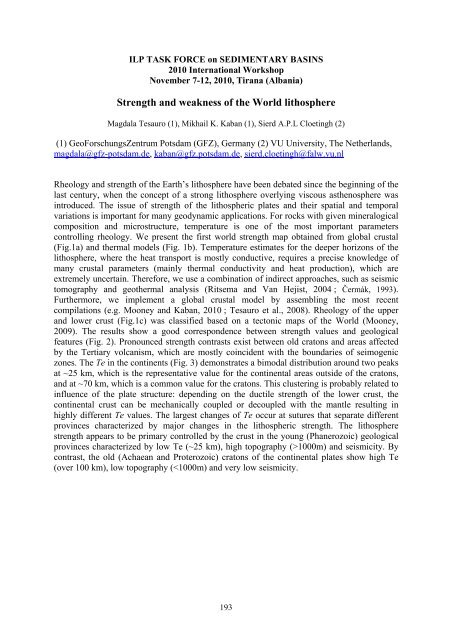DYNAMICS and ACTIVE PROCESSES - International Lithosphere ...
DYNAMICS and ACTIVE PROCESSES - International Lithosphere ...
DYNAMICS and ACTIVE PROCESSES - International Lithosphere ...
You also want an ePaper? Increase the reach of your titles
YUMPU automatically turns print PDFs into web optimized ePapers that Google loves.
ILP TASK FORCE on SEDIMENTARY BASINS<br />
2010 <strong>International</strong> Workshop<br />
November 7-12, 2010, Tirana (Albania)<br />
Strength <strong>and</strong> weakness of the World lithosphere<br />
Magdala Tesauro (1), Mikhail K. Kaban (1), Sierd A.P.L Cloetingh (2)<br />
(1) GeoForschungsZentrum Potsdam (GFZ), Germany (2) VU University, The Netherl<strong>and</strong>s,<br />
magdala@gfz-potsdam.de, kaban@gfz.potsdam.de, sierd.cloetingh@falw.vu.nl<br />
Rheology <strong>and</strong> strength of the Earth’s lithosphere have been debated since the beginning of the<br />
last century, when the concept of a strong lithosphere overlying viscous asthenosphere was<br />
introduced. The issue of strength of the lithospheric plates <strong>and</strong> their spatial <strong>and</strong> temporal<br />
variations is important for many geodynamic applications. For rocks with given mineralogical<br />
composition <strong>and</strong> microstructure, temperature is one of the most important parameters<br />
controlling rheology. We present the first world strength map obtained from global crustal<br />
(Fig.1a) <strong>and</strong> thermal models (Fig. 1b). Temperature estimates for the deeper horizons of the<br />
lithosphere, where the heat transport is mostly conductive, requires a precise knowledge of<br />
many crustal parameters (mainly thermal conductivity <strong>and</strong> heat production), which are<br />
extremely uncertain. Therefore, we use a combination of indirect approaches, such as seismic<br />
tomography <strong>and</strong> geothermal analysis (Ritsema <strong>and</strong> Van Hejist, 2004 ; � ermák, 1993).<br />
Furthermore, we implement a global crustal model by assembling the most recent<br />
compilations (e.g. Mooney <strong>and</strong> Kaban, 2010 ; Tesauro et al., 2008). Rheology of the upper<br />
<strong>and</strong> lower crust (Fig.1c) was classified based on a tectonic maps of the World (Mooney,<br />
2009). The results show a good correspondence between strength values <strong>and</strong> geological<br />
features (Fig. 2). Pronounced strength contrasts exist between old cratons <strong>and</strong> areas affected<br />
by the Tertiary volcanism, which are mostly coincident with the boundaries of seimogenic<br />
zones. The Te in the continents (Fig. 3) demonstrates a bimodal distribution around two peaks<br />
at ~25 km, which is the representative value for the continental areas outside of the cratons,<br />
<strong>and</strong> at ~70 km, which is a common value for the cratons. This clustering is probably related to<br />
influence of the plate structure: depending on the ductile strength of the lower crust, the<br />
continental crust can be mechanically coupled or decoupled with the mantle resulting in<br />
highly different Te values. The largest changes of Te occur at sutures that separate different<br />
provinces characterized by major changes in the lithospheric strength. The lithosphere<br />
strength appears to be primary controlled by the crust in the young (Phanerozoic) geological<br />
provinces characterized by low Te (~25 km), high topography (>1000m) <strong>and</strong> seismicity. By<br />
contrast, the old (Achaean <strong>and</strong> Proterozoic) cratons of the continental plates show high Te<br />
(over 100 km), low topography (




